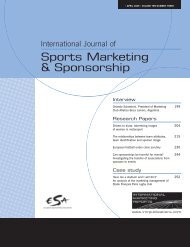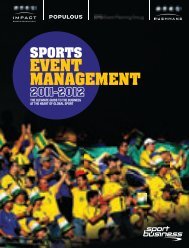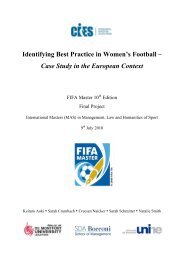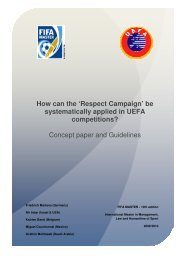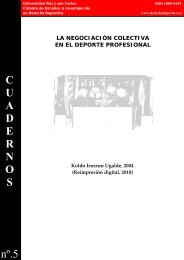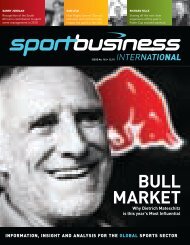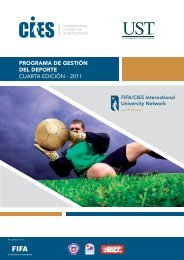Sports Marketing & Sponsorship - FIFA/CIES International University ...
Sports Marketing & Sponsorship - FIFA/CIES International University ...
Sports Marketing & Sponsorship - FIFA/CIES International University ...
- No tags were found...
Create successful ePaper yourself
Turn your PDF publications into a flip-book with our unique Google optimized e-Paper software.
Sustaining the raceUsing concepts such as sustainability and naturalcapital, the paper reviews some of the literaturepertaining to the sustainability of motorsport. It placesmotorsport within a broader environmental contextand draws upon the latest United Nations’environmental assessment (2007) to discuss some ofour planet’s natural ‘capital’ upon which motorsportdepends for its sustenance.Motorsport(professional race and amateur sport)” (p.1). Theynote that in the context of the motorsport industry, theterm ‘motor’ refers to the “provision (construction andpreparation) of cars and bikes”, while ‘sport’ refers tothe “infrastructure including clubs, circuits, promotion,insurance… that is needed to participate in or viewthe sport”. They also suggest that motorsport is part ofthe “leisure and entertainment industry” (pp.1-2).Angus et al identify some important parameters ofthe global motorsports industry. In 2005, theseincluded:RESEARCH PAPERThe Fédération <strong>International</strong>e de l’Automobile (FIA),the global governing body for motorsport, surprisingly,does not offer a definition of motorsport in its‘Statutes’, ‘Regulations’ or the <strong>International</strong> SportingCode (Fédération <strong>International</strong>e de l’Automobile,2009). The FIA does, however, define the term‘automobile’ as:A land vehicle propelled by its own means,running on at least four wheels not aligned,which must always be in contact with theground; the steering must be ensured by atleast two of the wheels, and the propulsion byat least two of the wheels.In the absence of an official definition of motorsport,and for the purpose of clarity, this paper will adopt thedefinition of motorsport offered by Angus, Aylett,Henry and Jenkins (2007, pp.1-2):We define motorsport broadly as competitiveracing by equivalent machines on a frequent basis,on designated tracks and circuits. These machinesinclude… motorcycles, moto-cross, karts, historiccars, drag, open-wheel, single-seat, sports, GT,Formula Ford, touring cars, rallying, sportscompact, CART, IRL and Formula One.Angus et al note that racing is organised around“series, championships, events and meetings arrangedby promoters, circuits and racing clubs at all levels• It was worth approximately £50 billion andrepresented 0.23% of global Gross DomesticProduct (GDP)• There were approximately 600 race circuits(excluding kart tracks)• There were 56 global motorsports events• On average, more than 52 million viewers watchedeach Formula One Grand Prix.Based on these measures, motorsport is clearly amajor global industry with significant economic,entertainment and cultural dimensions.SustainabilityIn examining the sustainability of motorsport, it isappropriate to define the concept of sustainability.Dresner (2002, p.1) points out that the idea ofsustainability emerged about 50 years ago. Edwards(2005, p.11) notes that its origins are in theemergence of the “environmental movement of the1960s and 1970s”, whose antecedents were theUnited States’ New England transcendentalistmovement of the 1800s, which was concerned withthe human connection with nature. While the thinkingabout sustainability is not limited to the United States,a number of American conservationists, includingJohn Muir, Aldo Leopold and Rachel Carson – authorof the influential text Silent Spring, gave impetus tothe environmental movement from which the idea of82 <strong>International</strong> Journal of <strong>Sports</strong> <strong>Marketing</strong> & <strong>Sponsorship</strong> ● OCTOBER 2009 ●





